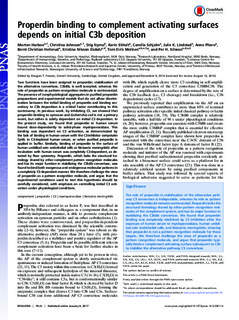| dc.description.abstract | Two functions have been assigned to properdin; stabilization of the alternative convertase, C3bBb, is well accepted, whereas the role of properdin as pattern recognition molecule is controversial. The presence of nonphysiological aggregates in purified properdin preparations and experimental models that do not allow discrimination between the initial binding of properdin and binding secondary to C3b deposition is a critical factor contributing to this controversy. In previous work, by inhibiting C3, we showed that properdin binding to zymosan and Escherichia coli is not a primary event, but rather is solely dependent on initial C3 deposition. In the present study, we found that properdin in human serum bound dose-dependently to solid-phase myeloperoxidase. This binding was dependent on C3 activation, as demonstrated by the lack of binding in human serum with the C3-inhibitor compstatin Cp40, in C3-depleted human serum, or when purified properdin is applied in buffer. Similarly, binding of properdin to the surface of human umbilical vein endothelial cells or Neisseria meningitidis after incubation with human serum was completely C3-dependent, as detected by flow cytometry. Properdin, which lacks the structural homology shared by other complement pattern recognition molecules and has its major function in stabilizing the C3bBb convertase, was found to bind both exogenous and endogenous molecular patterns in a completely C3-dependent manner. We therefore challenge the view of properdin as a pattern recognition molecule, and argue that the experimental conditions used to test this hypothesis should be carefully considered, with emphasis on controlling initial C3 activation under physiological conditions. | nb_NO |
